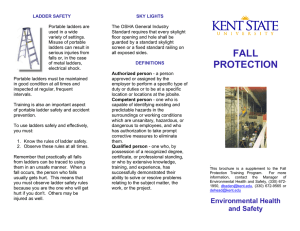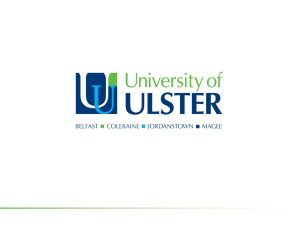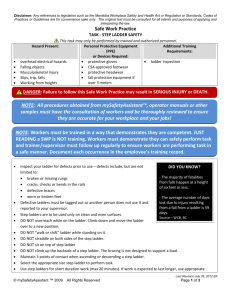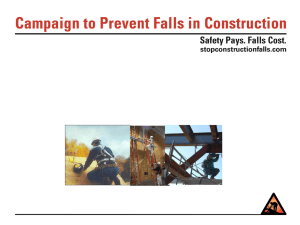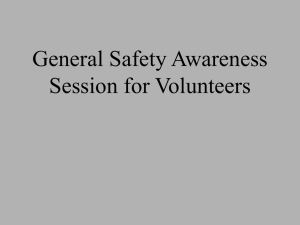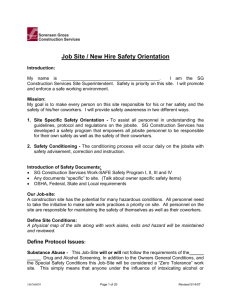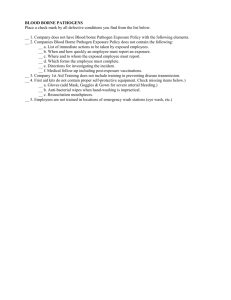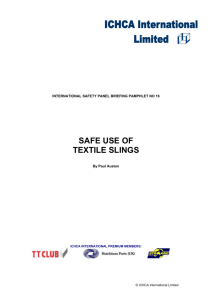OSHA Compliance Checklist
advertisement
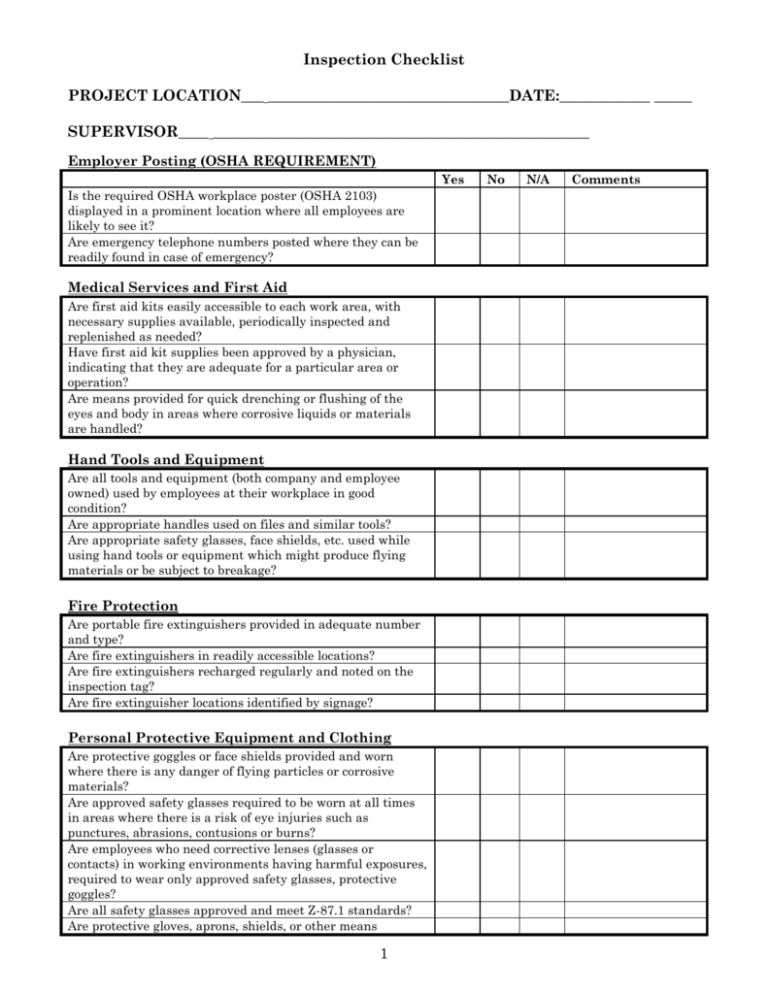
Inspection Checklist PROJECT LOCATION___ ________________________________DATE:____________ _____ SUPERVISOR____ __________________________________________________ Employer Posting (OSHA REQUIREMENT) Yes Is the required OSHA workplace poster (OSHA 2103) displayed in a prominent location where all employees are likely to see it? Are emergency telephone numbers posted where they can be readily found in case of emergency? Medical Services and First Aid Are first aid kits easily accessible to each work area, with necessary supplies available, periodically inspected and replenished as needed? Have first aid kit supplies been approved by a physician, indicating that they are adequate for a particular area or operation? Are means provided for quick drenching or flushing of the eyes and body in areas where corrosive liquids or materials are handled? Hand Tools and Equipment Are all tools and equipment (both company and employee owned) used by employees at their workplace in good condition? Are appropriate handles used on files and similar tools? Are appropriate safety glasses, face shields, etc. used while using hand tools or equipment which might produce flying materials or be subject to breakage? Fire Protection Are portable fire extinguishers provided in adequate number and type? Are fire extinguishers in readily accessible locations? Are fire extinguishers recharged regularly and noted on the inspection tag? Are fire extinguisher locations identified by signage? Personal Protective Equipment and Clothing Are protective goggles or face shields provided and worn where there is any danger of flying particles or corrosive materials? Are approved safety glasses required to be worn at all times in areas where there is a risk of eye injuries such as punctures, abrasions, contusions or burns? Are employees who need corrective lenses (glasses or contacts) in working environments having harmful exposures, required to wear only approved safety glasses, protective goggles? Are all safety glasses approved and meet Z-87.1 standards? Are protective gloves, aprons, shields, or other means 1 No N/A Comments provided against cuts, corrosive liquids and chemicals? Are hard hats provided and worn where there is danger of falling objects exist? Is appropriate foot protection required where there is the risk of foot injuries from hot, corrosive, poisonous substances, falling objects, crushing or penetrating actions? Are there written standard operating procedures for the selection and use of respirators where needed? Is protection against the effects of occupational noise exposure provided when sound levels exceed those of the OSHA noise standard? Are adequate work procedures, protective clothing and equipment provided and used when cleaning up spilled toxic or otherwise hazardous materials or liquids? Walkways Are walking surfaces kept clean and dry? Are walkways over hazards guarded on both sides? Are holes in the floor, sidewalk or other walking surface repaired properly, covered or otherwise made safe? Are ground openings guarded by a cover, a guardrail, or equivalent on all sides (except entrance to excavations)? Are bridges provided over trenches and similar hazards? Portable Ladders Are all ladders maintained in good condition, joints between steps and side rails tight, all hardware and fittings securely attached and moveable parts operating freely without binding or undue play? Are non-slip safety feet provided on each ladder? Are ladder rungs and steps free of grease and oil? Are employees instructed to face the ladder when ascending or descending? Are employees prohibited from using ladders that are broken, missing steps, rungs, or cleats, broken side rails or other faulty equipment? Are employees instructed not to use the top step of ordinary stepladders as a step? When portable rung ladders are used to gain access to trenches, boxes for rigging, delivered supplies, et., does the ladder always extend at least 3 feet above the elevated surface? Is it required that when portable rung or cleat type ladders are used, the base is so placed that slipping will not occur, or it is lashed or otherwise held in place? Portable (Power Operated) Tools and Equipment Are grinders, saws and similar equipment provided with appropriate safety guards? Are power tools used with the correct shield, guard, or attachment, recommended by the manufacturer? Are all cord-connected, electrically-operated tools and equipment effectively grounded or of the approved double insulated type? Are effective guards in place over belts, pulleys, chains, sprockets, on equipment such as concrete mixers, air compressors, etc.? 2 Is hoisting equipment available and used for lifting heavy objects, and are hoist ratings and characteristics appropriate for the task? Are ground-fault circuit interrupters provided on all temporary electrical 15 and 20 ampere circuits, used during periods of construction? Are pneumatic and hydraulic hoses on power-operated tools checked regularly for deterioration or damage? Is ground fault protection used where water or moisture is present? Powder Operated Tools Are all employees that use a powder actuated tool properly trained and “Certified” for the type of tool (ie: HILTI) ? Are all EMPLOYEES required to wear eye protection when operating? Are tools properly maintained and serviced to prevent a malfunction? Compressed Gas Cylinders Are cylinders legibly marked to clearly identify the gas contained? Are compressed gas cylinders stored in areas which are protected from external heat sources such as flames, intense radiant heat, electric arcs, or high temperature lines? Are cylinders stored or transported in a manner to prevent them creating a hazard by tipping, falling or rolling? Are valve protectors always placed on cylinders when the cylinders are not in use or connected for use? Hazard Communication (OSHA REQUIREMENT) Is there a list of hazardous substances used in the workplace? Is there a written hazard communication program dealing with Material Safety Data Sheets (MSDS), labeling, and employee training? Is there a Material Safety Data Sheet readily available for each hazardous substance used? Is there an employee training program for hazardous substances? Are there procedures for communicating hazards both to and from outside contractors? If the company has a labeling system, are containers labeled? Compressors and Compressed Air Are compressors equipped with pressure relief valves, and pressure gauges? Are air filters installed on the compressor intake? Are compressors operated and lubricated in accordance with the manufacturer’s recommendations? Are safety devices on compressed air systems checked frequently? Is the belt drive system totally enclosed to provide protection for the front, back, top, and sides? Are employees prohibited from using highly compressed air for cleaning purposes? Are safety chains or other suitable locking devices used at 3 couplings of high pressure hose lines where a connection failure would create a hazard? Hoist and Auxilliary Equipment Is it prohibited to use chains or rope slings that are kinked or twisted? Is it prohibited to wrap the hoist rope, or chain, around the load as a substitute for a sling? Is the operator instructed to avoid carrying loads over people? Are slings stored properly? Are chains checked for stretching and hooks checked for damage? Are damaged ropes, slings, chains or cables replaced and removed from the jobsite? Electrical Are portable electrical tools and equipment grounded or of the double insulated type? Do extension cords being used have a grounding conductor? Are multiple plug adaptors prohibited? Are ground-fault circuit interrupters installed on each temporary 15 or 20 ampere, 120 volt AC circuit at locations where construction, demolition, modifications, alterations or excavations are being performed? Is exposed wiring and cords with frayed or deteriorated insulation repaired or replaced promptly? Are flexible cords and cables free of splicing or taps? Is the location of electrical power lines and cables (overhead, underground, underfloor, other side of walls, etc.) determined before digging, drilling or similar work is begun? Is the use of metal ladders prohibited in areas where the ladder or the person using the ladder could come in contact with energized parts of equipment, fixtures or circuit conductors? Are employees who regularly work on or around energized electrical equipment or lines instructed in the cardio-pulmonary resuscitation (CPR) methods? Fueling Is it prohibited to fuel an internal combustion engine with a flammable liquid while the engine is running? Are smoking, open lights, open flames, or sparking, or arcing equipment prohibited near fueling or transfer of fuel operations? Material Handling Are motorized vehicles and mechanized equipment inspected daily or prior to use? Are hooks with safety latches or other arrangements used when hoisting materials so that slings or load attachments won’t accidentally slip off the hoist hooks? Are securing chains, ropes, or slings adequate for the job to be performed? 4
